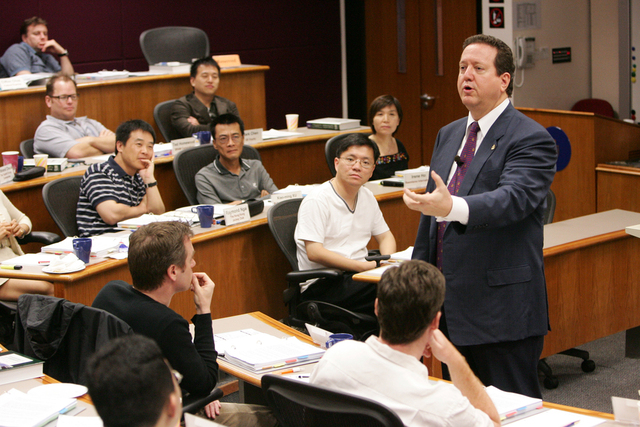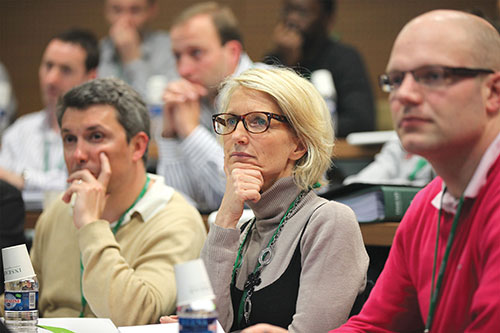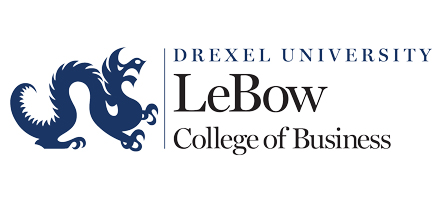
Class at the joint Kellogg-HKUST program
Meet the new boss,
Same as the old boss.
Today, those lyrics echo across the seven international campuses that make up the Kellogg-HKUST Executive MBA program. The ultimate East-meets-West experience, the program was the perennial No. 1 in the Financial Times’ annual rankings from 2009-2014. In recent years, it seemed to have slipped, playing bridesmaid to the Trium Global and Tsinghua-INSEAD EMBA programs.
Not anymore.
Buoyed by graduates nearing $500,000 average paychecks, the partnership between Northwestern University and the Hong Kong University of Science and Technology has returned to the top spot — even as INSEAD has cemented its dominance in global business education, placing two EMBA programs among the top five.
KELLOGG-HKUST EMBAs EARN $120,000 MORE PER YEAR THAN ANY OTHER GRADS
Salary accounts for 20% of the FT ranking, and this is where Kellogg-HKUST excels. Graduates reported earning $468,670 in U.S. dollars within three years of graduation, a 55% increase. Such compensation is impressive enough on its face. Compare it to the second highest-paying program, the Washington University-Fudan EMBA, where graduates pull down $348,086 — a $120,000 dropoff. The difference grows to over $140,000 when contrasted against Tsinghua-INSEAD and Trium, which ranked second and third overall, respectively, in the 2016 rankings.
Of course, Kellogg-HKUST has an inherent pay advantage based on its selectivity. An intimate program that graduates only 50 students a year, it caters to C-suite-level leadership. According to the school’s class profile from 1998-2016, CEOs, owners, and partners account for 15% of alumni, with managing and executive directors (18%) and vice presidents (14%) traditionally comprising large blocs of classes. That quality is also reflected in the program’s fourth-place FT ranking in “Work Experience,” a measure of “seniority of positions held, number of years in each position, company size and overseas work experience.” That said, the Kellogg-HKUST program doesn’t just recruit great students. It also develops them, with alumni now including key leaders at brands like Domino’s Pizza, Netflix, Federal Express, Goldman Sachs, and Bank of America.

INSEAD executive education students
For executives looking to move up, the Tsinghua-INSEAD 18-month EMBA program is the place to be. Take “Career Progress.” In this FT category, which is based on increases in level of seniority, the program ranked third overall, with graduates enjoying a 63% spike in pay. The Trium Global Executive MBA is the opposite. A partnership between HEC Paris, the London School of Economics and Political Science, and the New York University Stern School of Business, the program requires its busy executives to spend class time in London, California, New York, Paris, and Shanghai. Despite this requirement, the program attracts the crème de la crème, ranking first in “Work Experience.” At the same time, 85% of graduates agreed that they were able to achieve their goals at Trium, the second-highest percentage and a reflection of high satisfaction across the board.
AMERICAN EMBA PROGRAMS LAG BEHIND EUROPE, CHINA, AND SINGAPORE
Overall, joint MBA programs enjoy a decided advantage in the EMBA space, at least at the top. Among the top eight EMBA programs, six were joint programs, including Washington University-Fudan, UCLA-National University of Singapore, and Columbia University-London Business School. It’s easy to see why. For one, the schools are able to pool their resources, a decided advantage for programs that are relatively small like Trium (65 students) and UCLA-Singapore (45 students). The schools are also able to provide a truly international experience, with Kellogg-HKUST, for example, holding required courses at Northwestern and electives in Germany, Israel, China (Shanghai and Hong Kong), Canada, and Florida. Not to mention, an EMBA degree from a joint program expands student options, giving them access to alumni from multiple schools.
Among standalone programs, INSEAD fares best, ranking fourth, up five spots in just two years. The program posts solid numbers across the board, with the exception of salary, where INSEAD lags at $255,233, behind European competitors like IESE and IMD. However, this number still represents a $43,214 increase over the previous year.
Among this year’s Top 50 EMBA programs, the University of Hong Kong made the biggest move, climbing 16 spots to rank 42nd. The University of Cambridge also made an impressive jump, going from 24th to 15th, thanks to grads increasing their earnings by $11,600. BI Norwegian-Fudan, the University of Strathclyde, and Copenhagen Business School each rose nine spots, too. On the flip side, IMD took the biggest tumble, dropping from 18th to 27th, as its career progress rank tumbled 29 spots despite grads earning $11,047 more than the previous year’s survey.
While the U.S. programs are the envy of the full-time MBA market, their performance is conspicuously unimpressive in the EMBA rankings. The University of Chicago’s Booth School of Business ranks the highest at 14th, just ahead of Wharton at 16th, with both schools dropping two spots in 2016. Notably, both programs are dogged by low pay compared to peer schools, with Booth grads averaging $246,543 within three years of graduation and Wharton MBA for executives grads averaging $214,275 in the same period. In fact, Wharton grads saw their pay increase by just $5,863, slightly more than a third of Booth alums at $15,311. When it comes to pay, both programs trail behind 20th-ranked Duke and 24th-ranked Northwestern, whose EMBA grads gross $259,410 and $252,341, respectively.
Go to the third page to see the rankings of the top 5o executive MBA programs.




